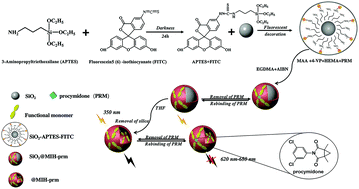Development and critical evaluation of a novel fluorescent nanosensor based on a molecularly imprinted polymer for the rapid detection of procymidone in ginseng†
Abstract
Effective methods are required to quantify the organochlorine pesticide procymidone due to its potentially harmful effects toward human health and the environment. Here, hydrophilic hollow imprinted microspheres were prepared via a simple method as fluorescent sensors (@MIH-prm) for the sensitive and selective detection of PRM in ginseng. A new method of adsorption efficiency evaluation for @MIH-prm was subsequently introduced (EBS%), the effective binding site, which provided a comprehensive evaluation of the performance compared with conventional methods. The results showed that @MIH-prm could detect PRM in filtered and diluted ginseng juice with high sensitivity (LOD, 0.569 nM) and a rapid detection rate (quantitative detection of PRM within 18 min). Good selectivity was observed in the presence of combinations of different pesticides, and the adsorption of PRM could be described by the pseudo-second-order kinetic model. PRM concentrations exhibited good linearity over 1–40 nM, and the accuracy (recovery rates, 99.2 to 103.1%) and precision (RSD at 1.0 × 10−9 M, 3.14%) indicated that @MIH-prm could be used for the quantitative analysis of PRM in complex matrices. Hence, @MIH-prm has good application potential in pollution control monitoring and enforcement.



 Please wait while we load your content...
Please wait while we load your content...